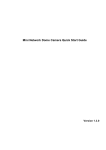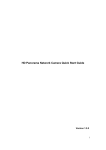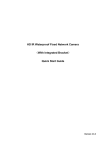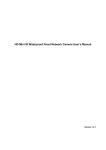Download Dahua EBW8600_EBW812..
Transcript
HD Fisheye Panorama Network Camera Quick Start Guide Version 1.1.0 i Welcome Thank you for purchasing our network camera! This user’s manual is designed to be a reference tool for your system. Please read the following safeguard and warnings carefully before you use this series product! Please keep this user’s manual well for future reference! 1.Electrical safety All installation and operation here should conform to your local electrical safety codes. The power shall conform to the requirement in the SELV (Safety Extra Low Voltage) and the Limited power source is rated 12V DC in the IEC60950-1. This series product supports PoE too. Note: Do not connect these two power supplying sources to the device at the same time; it may result in device damage! We assume no liability or responsibility for all the fires or electrical shock caused by improper handling or installation. We are not liable for any problems caused by unauthorized modification or attempted repair. 2.Transportation security Heavy stress, violent vibration or water splash are not allowed during transportation, storage and installation. 3.Installation Do not apply power to the camera before completing installation. Please install the proper power cut-off device during the installation connection. Always follow the instruction guide the manufacturer recommended. 4.Qualified engineers needed All the examination and repair work should be done by the qualified service engineers. We are not liable for any problems caused by unauthorized modifications or attempted repair. 5.Environment This series network camera should be installed in a cool, dry place away from direct sunlight, inflammable, explosive substances and etc. i Please keep it away from the electromagnetic radiation object and environment. Please make sure the CCD (CMOS) component is out of the radiation of the laser beam device. Otherwise it may result in CCD (CMOS) optical component damage. Please keep the sound ventilation. Do not allow the water and other liquid falling into the camera. Thunder-proof device is recommended to be adopted to better prevent thunder. The grounding holes of the product are recommended to be grounded to further enhance the reliability of the camera. 6. Daily Maintenance Please shut down the device and then unplug the power cable before you begin daily maintenance work. Do not touch the CCD (CMOS) optic component. You can use the blower to clean the dust on the lens surface. Always use the dry soft cloth to clean the device. If there is too much dust, please use the water to dilute the mild detergent first and then use it to clean the device. Finally use the dry cloth to clean the device. Please put the dustproof cap to protect the CCD (CMOS) component when you do not use the camera. Dome enclosure is the optical component, do not touch the enclosure when you are installing the device or clean the enclosure when you are doing maintenance work. 7. Accessories Be sure to use all the accessories recommended by manufacturer. Before installation, please open the package and check all the components are included. Contact your local retailer ASAP if something is broken in your package. Accessory Name Amount Network Camera 1 Quick Start Guide 1 Installation Accessories Bag 1 CD 1 ii Table of Contents 1 Structure.......................................................................................................... 1 1.1 Device External Cable ...................................................................... 1 1.2 Dimensions ........................................................................................ 2 1.3 Bidirectional Talk ............................................................................... 2 1.3.1 Device-end to PC-end ................................................................ 2 1.3.2 PC-end to Device-end ................................................................ 3 1.4 2 3 4 Alarm Setup ....................................................................................... 3 Installation ....................................................................................................... 4 2.1 General Installation ........................................................................... 4 2.2 Device Installation Steps .................................................................. 4 2.3 Micro SD Card Installation ................................................................ 5 2.4 Manual Zoom Lens Focus Operation............................................... 6 Quick Configuration Tool ............................................................................... 7 3.1 Overview ............................................................................................ 7 3.2 Operation ........................................................................................... 7 Web Operation ............................................................................................... 9 4.1 Network Connection .......................................................................... 9 4.2 Login and Main Interface .................................................................. 9 4.3 Panorama Function on Web ........................................................... 11 4.3.1 Installation Mode....................................................................... 11 4.3.2 Display Mode ............................................................................ 11 Appendix Toxic or Hazardous Materials or Elements....................................... 12 iii 1 Structure 1.1 Device External Cable Figure 1- 1 The device external cable is shown in Figure 1- 1. Please refer to Sheet 1-1 for corresponding information about external cable functions. NO. Port Port Name Audio output Connector Function Description RCA Output audio signal to the speakers. RCA Input audio signal, receive the analog audio signal from the sound pick-up. 1 AUDIO OUT 2 AUDIO IN 3 LAN Network port Ethernet port Connect to standard Ethernet cable. 4 I/O I/O port - Connect I/O port 5 POWER Power input port - Connect DC 12V power, input power port Audio input port Sheet 1-1 Please refer to Sheet 1-2 for corresponding information about I/O port functions. Port Name I/O port Cable Number 1 Cable Port Name ALARM_NO Function Description Alarm output port. It is to output the alarm signal to the alarm device. NO:Normal open alarm output port. This port needs to be used with ALARM_COM port 1 Port Name Cable Number Cable Port Name 2 ALARM_COM Alarm output public port. 3 ALARM_IN1 Alarm input port 1. It is to receive the on-off signal from the external alarm source. 4 ALARM_IN2 Alarm input port 2. It is to receive the on-off signal from the external alarm source. 5 GND Ground port Function Description Sheet 1-2 1.2 Dimensions Note: There are two standards for side dimension of the device, which are: 33.7mm, 47.7mm and 36.6mm, 50.7mm. Please refer to the actual product model for more details. You can refer to the following figures for dimension information. The Unit is mm. See Figure 1-2 to Figure 1-4. Figure 1-2 Figure 1-3 Figure 1-4 1.3 Bidirectional Talk 1.3.1 Device-end to PC-end Device Connection Please connect the speaker or MIC to the audio input port of the PC, and then connect the earphones to the audio output port of the PC. Login the Web and then click the Talk button to enable the 2 bidirectional talk function. You can see the button becomes orange after you enabled the bidirectional talk function. Click Talk button again to stop the bidirectional talk function. Listening Operation At the device end, speak via the speaker or MIC, and then you can get the audio at the pc-end. 1.3.2 PC-end to Device-end Device Connection First connect the speaker or MIC to the audio input port of the PC, and then connect the earphones to the audio output port of the PC. Login the Web and then click the “Talk” button to enable the bidirectional talk function. You can see the button became orange after you enabled the bidirectional talk function. Click “Talk” button again to stop the bidirectional talk function. Bidirectional talk function and on-site listening function can’t be used at the same time for the device. Listening Operation At the PC end, speak via the speaker or MIC, and then you can get the audio at the device-end. 1.4 Alarm Setup Please refer to Figure 1-5 for more information about alarm setup. Figure 1-5 Please follow the steps listed below for alarm input and output connection. Step 1 Connect the alarm input device to the alarm input port (No.4 pin) of the I/O cable. Step 2 Connect alarm output device to alarm output port (No.1pin) and alarm output public port (No.2pin), The alarm output port supports NO (normal open) alarm device only. Step 3 Open WEB and set corresponding alarm input and output in the alarm setup. Please set the alarm input 01 port for the first channel of the I/O cable (No.4 pin). Then set corresponding NO/NC input according to the high/low level signal generated when alarm occurs to the alarm input device. Step 4 Set the WEB alarm output. The alarm output 01 is for the alarm output port of the device. It is the No.1 pin of the I/O cable. 3 2 Installation Important Before you complete the installation and setup, do not remove the electrostatic attraction film on the transparent enclosure. Otherwise it may result in injury. After remove electrostatic attraction film, do not touch dome enclosure in case it may leave stain. Before the installation, please make sure the installation surface can sustain at least 3X weight of the bracket and the camera. 2.1 General Installation Please refer to Figure 2- 1 for device installation information. You can see there are installation screws in the accessories bag for you to install the device conveniently. Figure 2- 1 2.2 Device Installation Steps Step 1 Take the installation position diagram from the accessories bag and then paste it on the installation ceiling or the wall according to the monitor area. Please dig three bottom holes of the plastic expansion bolts according to the diagram. If you need to dig a hole to pull through the cable on top of installation surface, you need to dig a cable exit hole of no less than 28MM on the installation surface according to the installation positioning diagram, which makes the network cable go through. 4 Step 2 Insert 3 expansion bolts from the accessories bag into the bottom holes and lock them firmly, adjust the position of device installation pedestal and pull the cable through the cable exit hole on the installation surface. Step 3 Aim 3 screw fixed holes on the installation chassis to 3 plastic expansion bolt fixed holes on the installation surface, then tighten 3 ST3 self-tapping screws into 3 plastic expansion bolts and fasten them firmly, fix the installation chassis on the installation surface. Step 4 When installing dome body, find the little gap on the dome body and make it corresponding to the “TOP” direction on the installation chassis, rotate the dome body in clockwise direction and secure it firmly. So far, installation is completed. Note: Please refer to Micro SD card installation steps if you need to install Micro SD card, and operate step 4 after the installation. Note: If connect the host GND to ground lead, may improve device reliability. The GND locates next to exit hole on the rear side of the chassis and the GND screw is M3. Figure 2- 2 2.3 Micro SD Card Installation Use the inner hex wrench from the accessories bag to unfasten the 3 inner hex screws on the dome camera enclosure, find the Micro SD card slot position according to the following figure then fasten back the 3 screws on the dome camera enclosure after the Micro SD card is inserted. Note: 5 Please make sure the wire between power panel and device motherboard is firm, otherwise may cause abnormity. Please put the enclosure back and fasten the screws tightly to prevent dust. Figure 2-3 2.4 Manual Zoom Lens Focus Operation The lens of the HD panorama dome network camera is 360°, no manual zoom is required when it is operated by in-ceiling mount or ground mount. The lens of the HD panorama dome network camera is 185°, no manual zoom is required when it is operated by wall mount. 6 3 Quick Configuration Tool 3.1 Overview Note: Quick configuration tool can search current IP address, modify IP address. At the same time, you can use it to upgrade the device. Please note the tool only applies to the IP addresses in the same segment. 3.2 Operation Double click the “ConfigTools.exe”icon, you can see an interface is shown as in Figure 3- 1. In the device list interface, you can view device IP address, port number, subnet mask, default gateway, MAC address and etc. Figure 3- 1 Select one IP address and then right click mouse, you can see an interface is shown as in Figure 3-1. Select the “Open Device Web” item; you can go to the corresponding web login interface. Figure 3-2 If you want to modify the device IP address without logging in the device web interface, you can go to the configuration tool main interface to set. In the configuration tool search interface (Figure 3-1), 7 please select a device IP address and then double click it to open the login interface. Or you can select an IP address and then click the Login button to go to the login interface. See Figure 3-3. In Figure 3-3, you can view device IP address, user name, password and port. Please modify the corresponding information to login. Please note the port information here shall be identical with the port value you set in TCP port in Web Network interface. Otherwise, you cannot login the device. If you are using device background upgrade port 3800 to login, other setups are all invalid. Figure 3-3 After you logged in, the configuration tool main interface is shown as below. See Figure 3-4. Figure 3-4 For detailed information and operation instruction of the quick configuration tool, please refer to the Quick Configuration Tool User’s Manual included in the resources CD. 8 4 Web Operation This series network camera products support the Web access and management via PC. Web includes several modules: Monitor channel preview, system configuration, alarm and etc. 4.1 Network Connection Please follow the steps listed below for network connection. Make sure the network camera has connected to the network properly. Please set the IP address, subnet mask and gateway of the PC and the network camera respectively. Network camera default IP address is 192.168.1.108. Subnet mask is 255.255.255.0. Gateway is 192.168.1.1 Use order ping ***.***.***.*** (* network camera address) to check connection is OK or not. 4.2 Login and Main Interface Open IE and input network camera address in the address bar. For example, if your camera IP is 192.168.1.108, then please input http:// 192.168.1.108 in IE address bar. See Figure 4- 1. Input your IP address here Figure 4- 1 The login interface is shown as below. See Figure 4- 2. Please input your user name and password. Default factory name is admin and password is admin. Note: For security reasons, please change your password after you first login. 9 Figure 4- 2 After you successfully logged in, please install WEB plug-in unit. Please refer to the Web Operation Manual included in the resource CD for detailed operation instruction. See Figure 4-3. Figure 4-3 10 4.3 Panorama Function on Web There is a panorama icon at the lower-left corner of web interface and you can click it to view installation mode and display mode on the right. Note: Please set corresponding installation mode on Web according to actual installation condition otherwise it may appear abnormity for the image display. 4.3.1 Installation Mode There are three modes: wall mount, in-ceiling and ground. Wall mount: It is wall mount and the camera is pointing to the front. In-ceiling: It is the in-ceiling mount and the camera is pointing to the bottom. Ground: It is the ground installation and the camera is pointing to the top. 4.3.2 Display Mode There are six modes: 1O, 360°1-window, dual-picture panorama, 1-window, 90°4-window and 1+3 mode. 1O: Fisheye original image mode. 360°1-window: It takes the whole panorama and is one-window 360 degrees panorama. Dual-picture panorama: It is the dual-window 180 degrees panorama. 1-window: It is to display one of the four windows. It can show the video around the 360 degrees panorama. You can select video and then implement corresponding operation. Where you can: 1. Adjust camera direction via arrow keys. Click OK to restore default position. 2. Step length is mainly used for speed adjustment as the longer the step, the higher the speed. Zoom step length is to adjust zoom speed; movement step length is to adjust rotation speed per step; rotation step length is to adjust clockwise/counterclockwise rotation speed. 90°4-window: Panorama 360 degrees is divided into four windows. Each window has 90 degrees and totally displayed in four channels. It can be operated in a similar way with 1-window. 1+3 mode: Display one fisheye original image + three local region images. Note: If it is under 1-window PTZ control mode, 1+3 mode, or 4-window mode, it will support following functions: left button drag, click and view and right button box zoom. 11 Appendix Toxic or Hazardous Materials or Elements Toxic or Hazardous Materials or Elements Component Name Pb Hg Cd Cr VI PBB PBDE Circuit Board Component ○ ○ ○ ○ ○ ○ Device Case ○ ○ ○ ○ ○ ○ Wire and Cable ○ ○ ○ ○ ○ ○ Packing Components Accessories ○ ○ ○ ○ ○ ○ ○ ○ ○ ○ ○ ○ O: Indicates that the concentration of the hazardous substance in all homogeneous materials in the parts is below the relevant threshold of the SJ/T11363-2006 standard. X: Indicates that the concentration of the hazardous substance of at least one of all homogeneous materials in the parts is above the relevant threshold of the SJ/T11363-2006 standard. During the environmental-friendly use period (EFUP) period, the toxic or hazardous substance or elements contained in products will not leak or mutate so that the use of these (substances or elements) will not result in any severe environmental pollution, any bodily injury or damage to any assets. The consumer is not authorized to process such kind of substances or elements, please return to the corresponding local authorities to process according to your local government statutes. Note This user’s manual is for reference only. Slight difference may be found in user interface. All the designs and software here are subject to change without prior written notice. All trademarks and registered trademarks mentioned are the properties of their respective owners. If there is any uncertainty or controversy, please refer to the final explanation of us. Please visit our website for more information. 12





































